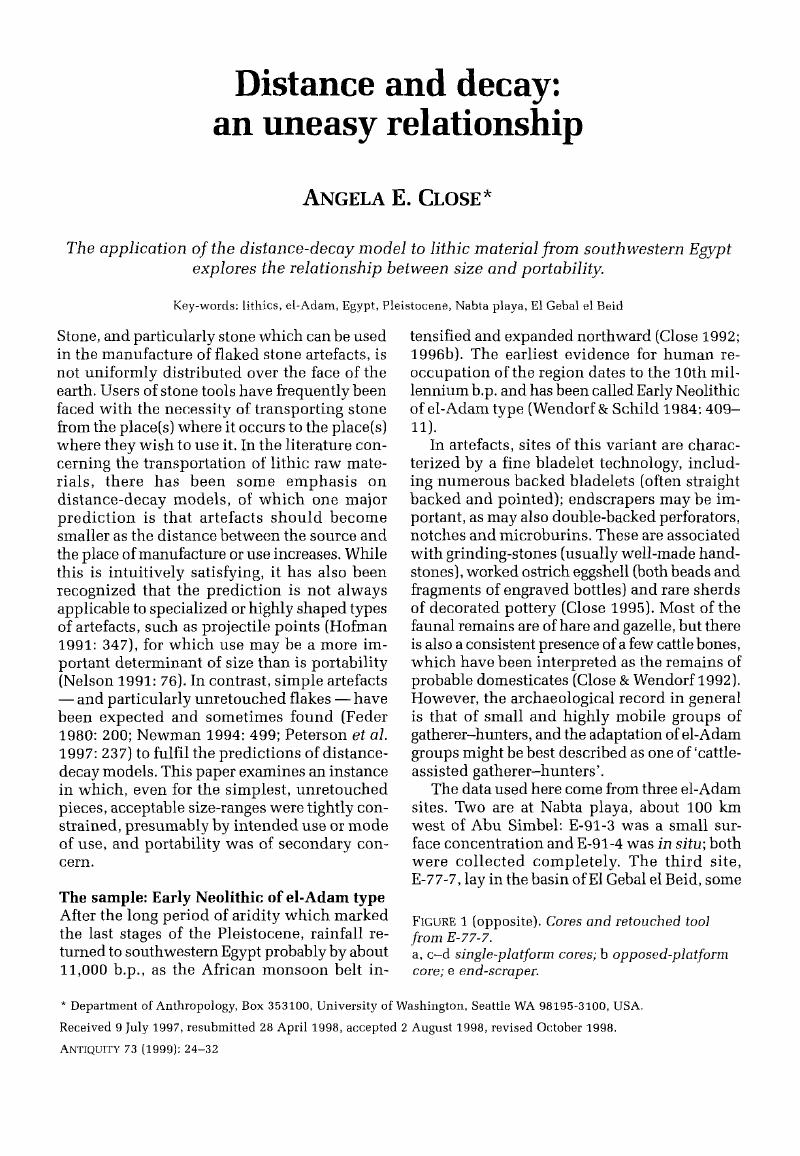Crossref Citations
This article has been cited by the following publications. This list is generated based on data provided by Crossref.
Odell, George H.
2000.
Stone Tool Research at the End of the Millennium: Procurement and Technology.
Journal of Archaeological Research,
Vol. 8,
Issue. 4,
p.
269.
Close, Angela E.
2000.
Reconstructing Movement in Prehistory.
Journal of Archaeological Method and Theory,
Vol. 7,
Issue. 1,
p.
49.
Burger, Richard L.
Chávez, Karen L. Mohr
and
Chávez, Sergio J.
2000.
Through the Glass Darkly: Prehispanic Obsidian Procurement and Exchange in Southern Peru and Northern Bolivia.
Journal of World Prehistory,
Vol. 14,
Issue. 3,
p.
267.
Dickson, D. Bruce
and
Gang, G.-Young
2002.
Evidence of the Emergence of “Modern” Behavior in the Middle and Later Stone Age Lithic Assemblages at Shurmai Rockshelter (GnJm1) and Kakwa Lelash Rockshelter (GnJm2) in the Mukogodo Hills of North-Central Kenya.
African Archaeological Review,
Vol. 19,
Issue. 1,
p.
1.
Close, Angela E.
2002.
Backed Bladelets Are a Foreign Country.
Archaeological Papers of the American Anthropological Association,
Vol. 12,
Issue. 1,
p.
31.
Kuhn, Steven L.
2004.
Upper Paleolithic raw material economies at Üçağızlı cave, Turkey.
Journal of Anthropological Archaeology,
Vol. 23,
Issue. 4,
p.
431.
Eerkens, Jelmer W.
Spurling, Amy M.
and
Gras, Michelle A.
2008.
Measuring prehistoric mobility strategies based on obsidian geochemical and technological signatures in the Owens Valley, California.
Journal of Archaeological Science,
Vol. 35,
Issue. 3,
p.
668.
Beck, R. Kelly
2008.
Transport Distance and Debitage Assemblage Diversity: An Application of the Field Processing Model to Southern Utah Toolstone Procurement Sites.
American Antiquity,
Vol. 73,
Issue. 4,
p.
759.
Blumenschine, Robert J.
Masao, Fidelis T.
Tactikos, Joanne C.
and
Ebert, James I.
2008.
Effects of distance from stone source on landscape-scale variation in Oldowan artifact assemblages in the Paleo-Olduvai Basin, Tanzania.
Journal of Archaeological Science,
Vol. 35,
Issue. 1,
p.
76.
Holdaway, Simon
Wendrich, Willeke
and
Phillipps, Rebecca
2010.
Identifying low-level food producers: detecting mobility from lithics.
Antiquity,
Vol. 84,
Issue. 323,
p.
185.
Smith, Geoffrey M.
Middleton, Emily S.
and
Carey, Peter A.
2013.
Paleoindian technological provisioning strategies in the northwestern Great Basin.
Journal of Archaeological Science,
Vol. 40,
Issue. 12,
p.
4180.
Aranguren, Biancamaria
Cavulli, Fabio
D'Orazio, Massimo
Grimaldi, Stefano
Longo, Laura
Revedin, Anna
and
Santaniello, Fabio
2015.
Territorial exploitation in the Tyrrhenian Gravettian Italy: The case-study of Bilancino (Tuscany).
Quaternary International,
Vol. 359-360,
Issue. ,
p.
442.
Moreau, Luc
Brandl, Michael
and
Nigst, Philip R.
2016.
Did prehistoric foragers behave in an economically irrational manner? Raw material availability and technological organisation at the early Gravettian site of Willendorf II (Austria).
Quaternary International,
Vol. 406,
Issue. ,
p.
84.
Hughes, Richard E.
2018.
Obsidian studies in California archaeology.
Quaternary International,
Vol. 482,
Issue. ,
p.
67.
Gómez de Soler, Bruno
Soto, María
Vallverdú, Josep
Vaquero, Manuel
Bargalló, Amèlia
Chacón, María Gema
Romagnoli, Francesca
and
Carbonell, Eudald
2020.
Neanderthal lithic procurement and mobility patterns through a multi-level study in the Abric Romaní site (Capellades, Spain).
Quaternary Science Reviews,
Vol. 237,
Issue. ,
p.
106315.
Glauberman, Phil
Gasparyan, Boris
Wilkinson, Keith
Frahm, Ellery
Nahapetyan, Samvel
Arakelyan, Dmitri
Raczynski-Henk, Yannick
Haydosyan, Hayk
and
Adler, Daniel S.
2020.
Late Middle Paleolithic Technological Organization and Behavior at the Open-Air Site of Barozh 12 (Armenia).
Journal of Paleolithic Archaeology,
Vol. 3,
Issue. 4,
p.
1095.
Reeves, Jonathan S.
Braun, David R.
Finestone, Emma M.
and
Plummer, Thomas W.
2021.
Ecological perspectives on technological diversity at Kanjera South.
Journal of Human Evolution,
Vol. 158,
Issue. ,
p.
103029.
Schmuck, Nicholas
Carlson, Risa J.
Reuther, Joshua
Baichtal, James F.
Butler, Don H.
Carlson, Eric
and
Rasic, Jeffrey T.
2022.
Obsidian source classification and defining “local” in early Holocene Southeast Alaska.
Geoarchaeology,
Vol. 37,
Issue. 3,
p.
466.
Shen, Xuke
Perreault, Charles
Xia, Huan
Yao, Juanting
Liu, Yishou
Zhang, Dongju
and
Chen, Fahu
2022.
Exploitation of lydite and jasper by Epipaleolithic foragers in the Northeastern Tibetan Plateau and surrounding regions.
Archaeological and Anthropological Sciences,
Vol. 14,
Issue. 7,
Brandl, Michael
Martinez, Maria M.
Hauzenberger, Christoph
Filzmoser, Peter
Milić, Bogdana
and
Horejs, Barbara
2025.
Unveiling Neolithic Economic Behavior: A Novel Approach to Chert Procurement at Çukuriçi Höyük, Western Anatolia.
Journal of Archaeological Method and Theory,
Vol. 32,
Issue. 1,


